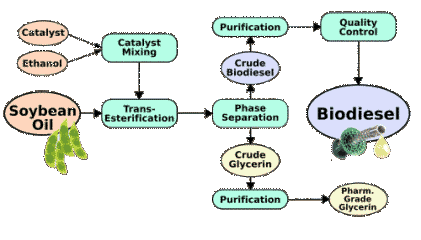






Expect storage of:
Methanol (1230,...DOT guide 131)..or..
Ethanol (1170,...DOT guide 127)
Potassium Hydroxide (1813,...DOT guide 154)..or..
Sodium Hydroxide (1823,...DOT guide154)
Sodium Methoxide
(During a process)
Sulfuric Acid (1830,...DOT guide137)
Phosphoric acid (1805,...DOT guide154)
Oils
such as rapeseed, canola, corn, soy or sunflower oil, and commercial oils in general "Combustible liquid, n.o.s.
(1993,...DOT guide128)
Diesel fuel
(for making B20, B80 etc.)
(1993,...DOT guide128)
Biodiesel containers (jugs, drums etc.)
Waste products
(such as glycerin)
Although there are a variety of manufacturing processes